Cartoons: Mirth at the Market
Want even more laughs? Subscribe to the magazine for cartoons, art, inspiring stories, fiction, humor, and features from our archives.
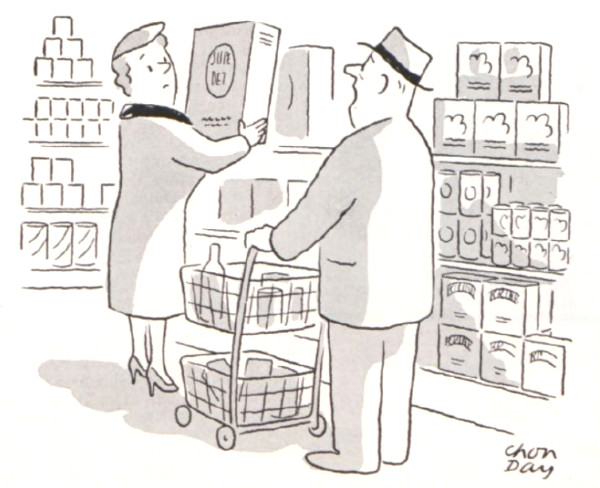
Chon Day
September 3, 1955
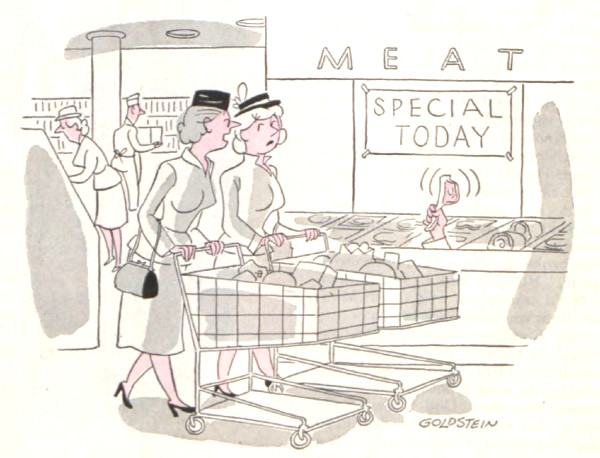
Goldstein
August 14, 1954
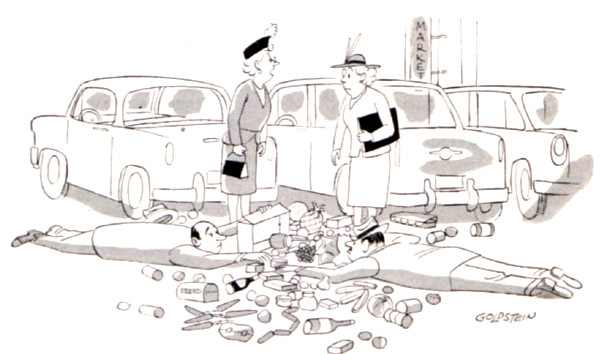
Goldstein
July 17, 1954
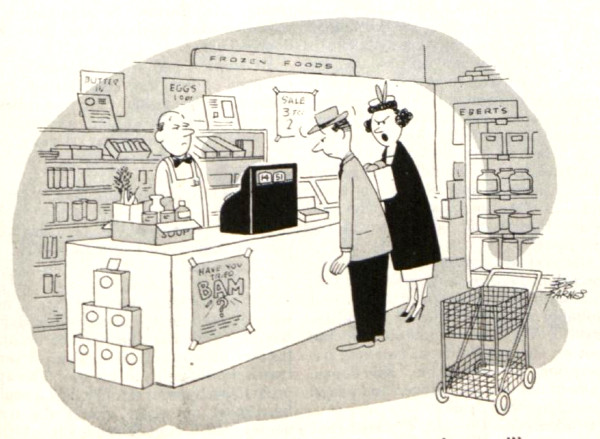
Bob Barnes
May 5, 1951
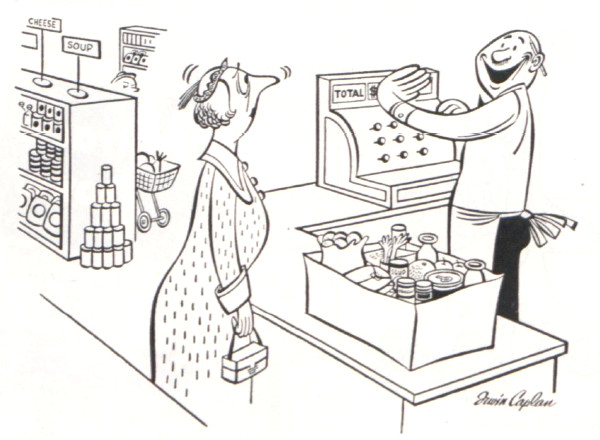
Irwin Caplan
April 21, 1951
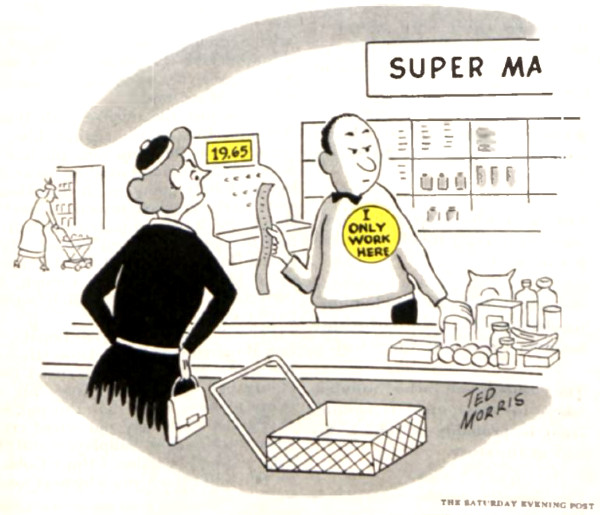
April 10, 1954
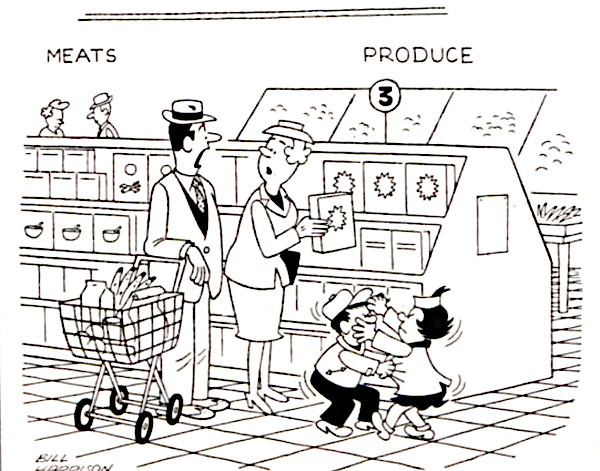
Bill Harrison
February 8, 1958
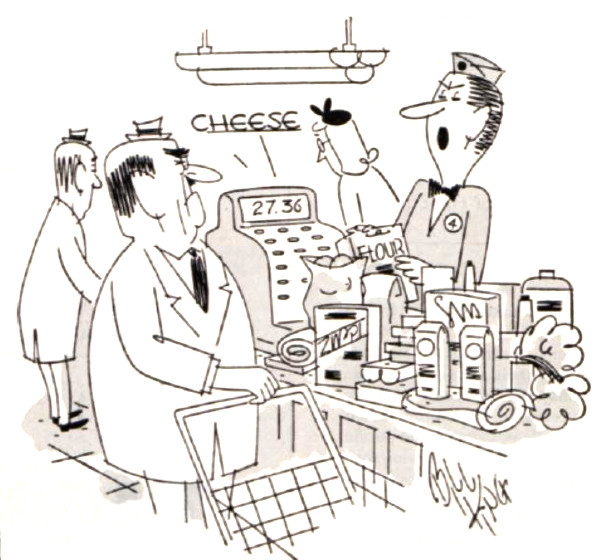
Bill King
November 19, 1955
Want even more laughs? Subscribe to the magazine for cartoons, art, inspiring stories, fiction, humor, and features from our archives.
Contrariwise: More Is Not Better
The variety of choice today, especially in entertainment and merchandise, is almost beyond comprehension. Not that long ago, there were only three major national TV networks. Today, there are hundreds, no, thousands of channels. How much TV can a person watch?
Going shopping? There’s exponentially more to choose from at your local supermarket in almost every category. As recently as the 1990s, an individual grocery store carried about 7,000 items. Today that number is 40,000 to 50,000, according to Michael Ruhlman, author of Grocery: The Buying and Selling of Food in America. There are 35 brands of mustard alone according to Wikipedia, and that doesn’t include sub-brands. (Grey Poupon offers Dijon, Whole Grain, and Spicy Brown.) How much mustard does a person need?
It’s not just groceries, of course. Need a power saw at Lowes? How about paint for your wall? So many options you could reasonably throw up your hands in despair.
Yet, I’m willing to bet if someone asked you whether you’d prefer more choices in life or fewer, you’d pick “more” since, why not? More is better, right?
(“More anything?” the flight attendant asked Jerry Seinfeld when he found himself seated in first class. “More everything!” he replied.)
Except, it turns out, more isn’t better. Here’s what you lose when you have unlimited choices: First, peace of mind. It’s unnerving to have to go through an enormous menu of options, since it takes effort to sift through the pros and cons of each, and what if you choose wrong?
In an oft-cited study done at Wharton, customers in a gourmet grocery story were watched as they passed a display of either 6 or 24 types of jam. While more customers were drawn to the larger display, only 3 percent of shoppers who passed by bought jam at that table. Meanwhile, 30 percent made a purchase from the limited-choice table. As the authors wrote, “It is not that people are saddened by the decisions they make in the face of abundant options, but rather that they are rendered unsure, burdened by the responsibility of choosing optimally.”
Another way to put it is they were beset by FOMO, fear of missing out. FOMO isn’t a factor when there are only six available options.
It’s actually unnerving to have to go through an enormous menu of options. What if you choose wrong?
But beyond our confusion when we’re faced with a cornucopia of choice, we have also lost a sense of community. Those three national TV networks back in the day aired shows that nearly everyone watched and that you could talk about with the confidence that they were well known by all. Today, you can’t assume that any of your friends or coworkers are on the same page. You want to talk about The Crown? Sorry, your friend is into fishing shows.
Or, let’s say you’re both into fishing shows. Are you more of a Deadliest Catch type or a Wicked Tuna fan? Not to leave out Battlefish, Monster Fish, Fish Mavericks, or Fishing Adventurer.
It’s nice, of course, that there are so many niche choices — it means that there’s something for almost everyone, if not on television then certainly on the internet. And frankly, many of those old shows haven’t aged well, and our new choices are much better and more interesting. But the down side is that these insular interest groups often end up cutting off their fans from the rest of society. And so, at a time when so many forces seem to be driving us apart, our harmless hobbies and entertainment choices just feed those feelings of division when our society is crying out for more unity.
Look, obviously we’re not going to put the genie back in the bottle. Even as we feel overwhelmed by choice, we certainly wouldn’t want someone else to decide which choices we should give up for the sake of illusory peace of mind. But I do sometimes long for the days when quotidian decision-making wasn’t always a frantic search among endless possibilities for that one, shining, perfect choice that we will never find.
This article is featured in the September/October 2020 issue of The Saturday Evening Post. Subscribe to the magazine for more art, inspiring stories, fiction, humor, and features from our archives.
Featured image: Shutterstock
7 Tips for Buying Clothes Online
Suffering through ill-fitting clothes, scratchy materials, and shipping costs may sway you to stick to your current closet rather than hunt through countless sites. However, now that many dressing rooms are closed, online shopping offers an experience similar to being in the store, without the concerns of social distancing. Below are some tips to enhance the digital shopping experience.
1. Know your measurements and check for size charts
The biggest concern for online clothes shopping is usually the fit, because sizes vary greatly depending on the brand. To skirt the issue, take your measurements beforehand and check the size chart. Some sites’ size charts even tell you exactly where and how to measure your body, so you start with accurate information.
2. Read the reviews
Reviews can can attest to the durability of the clothes, the condition they arrived in, their comfort, and often how true they are to the size chart. Some reviews also include pictures from customers.
3. Check the material
This tip may not be intuitive for first-time online shoppers because material is easy to access in a store, but checking the fabric is important to determine the fit, look, and texture of the clothing. Knowing what a piece of clothing is made of helps you consider how the clothes will shrink, stretch, and feel when you wear them.
4. Try to find free shipping
Many online stores offer free shipping if you spend more than a certain amount of money. Buy the clothes you need all at once, and you won’t lose your shirt on shipping costs.
5. Filter your results
Online stores tend to offer more options than brick-and-mortar places because there is no storage limit. The vast amount of choices can be overwhelming. Most sites offer filters that can narrow your search by size, style, cost, and so on and make your shopping experience more efficient.
6. Read the return policy
Even with these tips in mind, the clothes you buy online may just not work for you. And that’s okay — if you know the return policy. Just make sure to send back any unwanted clothes in the given time. If a store doesn’t allow returns, consider looking elsewhere. You can often find a link to the return policy at the bottom of any page on the site.
7. Save time to ship
It could take about three weeks for the clothing to reach you — longer if you’re shopping internationally. Normally, this isn’t a big deal; just remember not to buy the dress you need for your friend’s wedding the day before the event.
Featured image: anon_tae / Shutterstock
Saturday Evening Post History Minute: The Evolution of the Grocery Store from Corner Market to Colossus
See all of our History Minute videos.
Featured image: Store clerk in Minneapolis (Library of Congress)